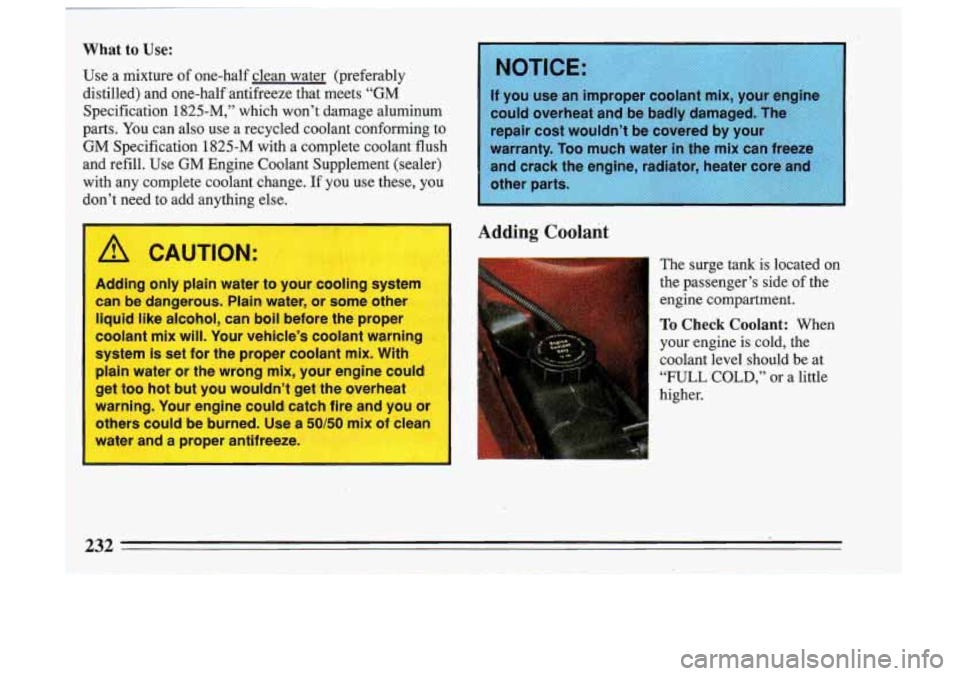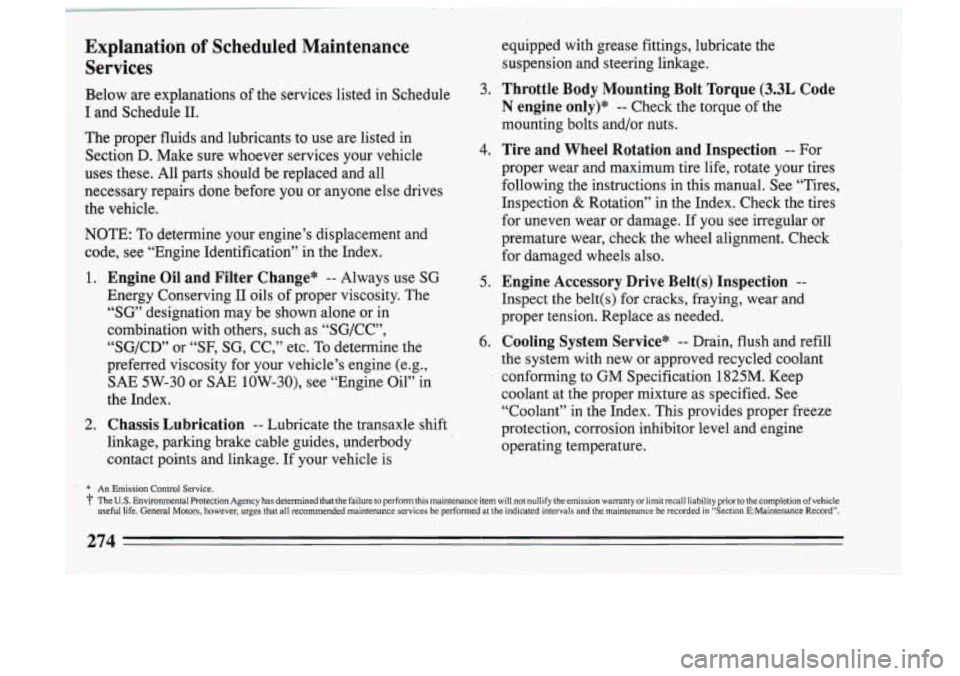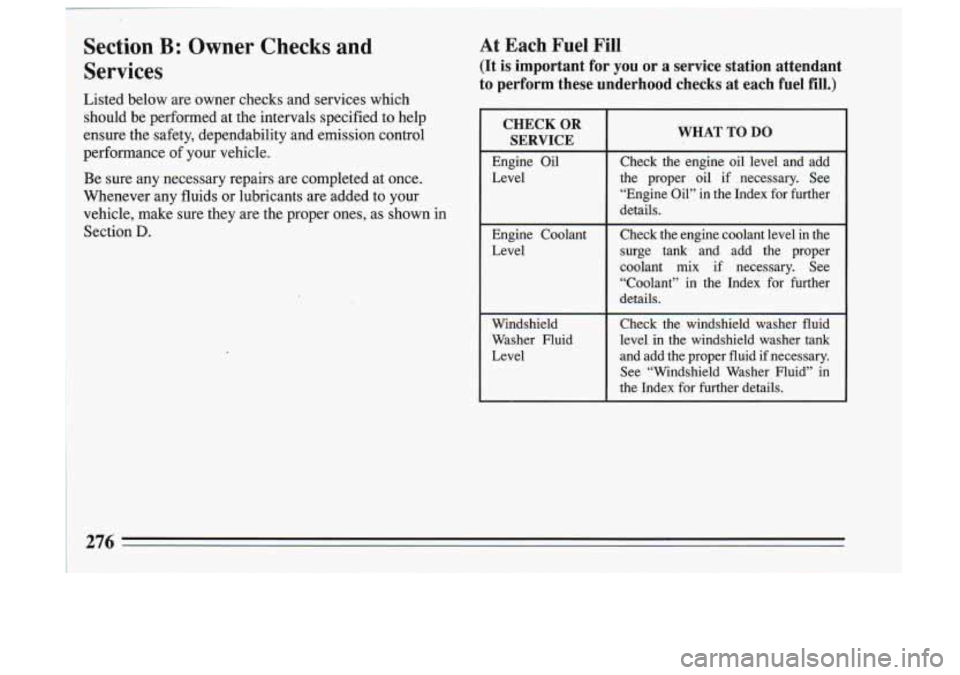1993 BUICK SKYLARK check engine
[x] Cancel search: check enginePage 233 of 306

~~~x~~~~ of one-half clean water (preferably
distilled) and one-half antifreeze that meets
“GM
Specification 1825-M,” which won’t damage aluminum
parts. You can also use a recycled coolant conforming to
GM Specification 1825-M with a complete coolant-flush
and refill. Use
GM Engine Coolant Supplement (sealer)
with any complete coolant change. If you use these, you
don’t need to add anything else.
n
1 A CAUTION:
Adding only plain water to your cooling system
can be dangerous. Plain water, or some other
liquid like alcohol, can boil before the proper
coolant mix will. Your vehicle’s coolant warning
system is set for the proper coolant mix. With
plain water or the wrong mix, your engine could
get too hot but you wouldn’t get the overheat
warning. Your engine could catch fire and you or
others could be burned. Use a
50150 mix of clean
water and a proper antifreeze.
I
warrantv. Too much water in the mix can freeze
Adding Coolant
The surge tank is located on
the passenger’s side
of the
engine compartment.
To Check Coolant: When
.your engine is cold, the
coolant level should be at
“FULL COLD,” or a little
higher.
Page 235 of 306

Power Steering Fluid What to Add:
I
How To Check Power Steering Fluid:
Unscrew the cap and wipe the dipstick with .a clean rag.
Replace the cap and completely tighten it. Then remove
the cap again and look at the fluid level on the dipstick.
When the engine compartment is hot, the level
When the engine compartment is cool, the level
should be at the
“HOT” mark.
should be at the “FULL COLD” mark. Refer
to the Maintenance Schedule
to determine what
kind
of fluid to use. See “Recommended Fluids and
Lubricants”
in the Index.
234
Page 267 of 306

IMPORTANT:
KEEP ENGINE OIL
AT THE PROPER
LEVEL AND CHANGE
AS
RECOMMENDED ,?.j :i i
Protection
Plan
Have you purchased the GM Protection Plan? The
Plan supplements your new vehicle warranties. See your
Buick dealer for details.
/
Introduction
A Word About Maintenance
We at General Motors want to help you keep your
vehicle in good working condition. But we don’t know
exactly how you’ll drive
it. You may drive very short
distances only a few times
a week. Or you may drive
long distances all the time in very hot, dusty weather.
You may use your Vehicle in making deliveries. Or you
may drive
it to work, to do errands or in many other
ways.
Because
of all the different ways people use their GM
vehicles, maintenance needs vary. You may even need
more frequent checks and replacements than you will
find in the schedules in this part.
So please read this part
and note how you drive. If you have any questions on
how to keep your vehicle in good condition, see your
Buick dealer, the place many GM owners choose to
have their maintenance work done.
Your dealer can be
relied upon to use proper parts and practices.
266
Page 275 of 306

Explanation of Scheduled Maintenance equipped with grease fittings, lubricate the
Services suspension and steering linkage.
Below are explanations
of the services listed in $chediie ‘ ‘ 3. Throttle Body Mounting; Bolt Torque (3.3L Code . , I:
I and Schedule 11.
The proper fluids and lubricants to use are listed in
Section
D. Make sure whoever services your vehicle
uses these. All parts should be replaced and all
necessary repairs done before you or anyone else drives
the vehicle.
NOTE:
To determine your engine’s displacement and
code, see “Engine 1dentific.ation” in the Index.
1. Engine Oil and Filter Change* -- Always use SG
Energy Conserving
I1 oils of proper viscosity. The
“SG, designation may be shown alone or in
combination with others, such as “SG/CC”,
“SG/CD” or “SF,
SG, CC,” etc. To determine the
preferred viscosity for your vehicle’s engine (e.g.,
SAE 5W-30 or SAE 10W-30), see “Engine Oil” in
the Index.
2. Chassis Lubrication -- Lubricate the transaxle shift
linkage, parking brake cable guides, underbody
contact points and linkage. If your vehicle is
An Emission Control Service.
N engine only)* -- Che& the torque of the
mounting bolts and/or nuts.
proper wear and maximum tire life, rotate your tires
following the instructions in this manual. See “Tires,
Inspection
& Rotation” in the Index, Check the tires
for uneven wear or damage. If you see irregular or
premature wear, check
the wheel alignment. Check
for damaged wheels also.
5. Engine Accessory Drive Belt@) Inspection --
Inspect the belt(s) for cracks, fraying, wear and
proper tension. Replace as needed.
6. Cooling System Service* -- Drain, flush and refill
the system with new or approved recycled coolant
conforming to GM Specification 1825M. Keep
coolant at the proper mixture as specified. See
“Coolant” in the Index. This provides proper freeze
protection, corrosion inhibitor level and engine operating temperature.
4. Tire and Wheel Rotation and Inspection -- For
The U.S. Environmental Protection Agency has determined that the failure to perform this maintenance item will not nullify the emission war\
ranty or limit recall liability prior to the completion of vehicle
useful life. General Motors, however, urges that all recommended maintenance services be performed at the indicated i\
ntervals and the maintenance be recorded in “Section EMaintenance Record”.
274
Page 276 of 306

Inspect hoses and replace if they are cracked,
swollen or deteriorated. Tighten screw-type hose
clamps. Clean the outside of the~radiator and air
conditioning condenser. Wash the pressure cap and
neck.
To help ensure proper operation, we recommend a
pressure test
of both the cooling system and the
pressure cap.
7. Transaxle Service -- Change both the fluid and
filter every
15,000 miles (25 000 km) if the vehicle
is mainly driven under one or more of these
conditions:
0 In heavy city traffic where the outside
temperature regularly reaches
90 F (32 C) or
higher.
0 In hilly or mountainous terrain.
When doing frequent trailer towing. (With some
models, you shouldn’t ever tow a trailer. See
“Towing a Trailer” in the Index.)
Uses such as found in taxi, police car or delivery
service. If you
do’ not use your vehicle under any of these
conditions, change both the fluid and filter every
100,000 miles (160 000 km).
8. Spark Plug Replacement* -- Replace spark plugs
with the proper type. See “Specifications Chart” in
the Index.
9. Spark Plug Wire Inspection (3.3L Code N engine
only)*?
-- Inspect for burns, cracks or other
damage. Check the boot fit at the coils and at the
spark plugs. Replace wires as needed.
10. Air Cleaner Filter Replacement* -- Replace every
30,000 miles
(50 000 km) or more often under dusty
conditions. Ask your dealer for the proper
replacement intervals for your driving conditions.
11. Fuel Tank, Cap and Lines Inspection”? -- Inspect
fuel
tank, cap and lines (including fuel rails and
injection assembly) for damage or leaks. Inspect fuel
cap gasket for an even filler neck imprint or any
damage. Replace parts as needed. Periodic
replacement of the fuel filter is not required.
* An Emission Control Service.
The
U.S. Environmental Protection Agency has determined that the failure to perform this maintenance item will not nullify the emission warranty or limit recall liability prior to the completion of vehicle
useful life. General Motors, however, urges that all recommended maintenance services be performed at the indicated intervals and the maintenance be recorded in “Section EMaintenance Record”.
Page 277 of 306

Section €5: Owner Checks and
Services
I Listed below are owner checks and services which
should be performed at the intervals specified to help
ensure the safety, dependability and emission control
performance of your vehicle.
Be sure any necessary repairs are completed at once.
Whenever anv fluids or lubricants are added to vour
At Each Fuel Fill
(It is important for you or a service station attendant
to perform these underhood checks at each fuel
fill.)
CHECK OR
I SERVICE I WHAT TO DO
Engine Oil Check the engine oil level and add
Level the proper oil if necessary. See
“Engine
Oil“ in the Index for further .r .I
vehicle, make sure they are the proper ones, as shown in details.
Section D. Engine Coolant Check the engine coolant level in the
Level surge tank and add the proper
coolant mix
if necessary. See
“Coolant” in the Index for further
details.
Windshield Check the windshield washer fluid
Washer Fluid level in the windshield washer tank
Level and add the proper fluid
if necessary.
See “Windshield Washer Fluid” in
the Index for further details.
Page 278 of 306

At Least Once A Month
CHECK OR SERVICE
Tire Inflation
WHAT TO DO
Check tire inflation. Make sure they
are inflated to the pressures specified
on the Tire-Loading Information
label located on the rear edge of the
driver’s door. See “Tires” in the
Index for further details.
At Least Once A Year
CHECK OR
SERVICE
I WHAT TO DO
Key Lock
Lubricate all body door hinges. Also
Body the
lubricant specified in Section
D. Cylinders Lubricate the
key lock cylinders with
Lubrication lubricate all hinges and latches,
including those for the hood, glove
box door and console door. Section
D tells you what to use.
CHECK OR
SERVICE
Starter Switch
WHAT TO DO
kAUTION: When you are
doing this check, the vehicle
could move suddenly.
If it
does, you or others could be
injured. Follow the steps
bellow.
- 1
1. Before you start, be sure you have
enough room around the vehicle.
2. Firmly apply both the parking brake
(see “Parking Brake” in the Index if
necessary) and the regular brake.
NOTE:
Do not use the accelerator
pedal, and be ready to
turn off the
engine immediately if it starts.
3. Try to start the engine in each gear.
The starter should work only in
“P’
(Park) or “N” (Neutral). If the starter
works in any other position, your
vehicle needs service.
277
Page 300 of 306

.... +,..
Maintenance Inspections
.................................. 279
Record
...................................... 282
Schedule
.................................... 265
Underbody
.................................. 255
Malfunction Indicator Lamp
....................... 1 13
Manual Lumbar Support
........................... 15
Manualseat
..................................... 14
Manual Seat. Four Way
............................ 15
Markings. Pavement
............................. 144
Master Cylinder. Brake
........................... 236
Methanol In Gasoline
............................. 217
Mirrors
........................................ 102
Mirrors. Convex Outside
.......................... 104
Mirrors. Visor Vanity
............................. 104
Mist. Driving in
................................. 164
Mountain Driving
................................ 170
MTBE in Gasoline
............................... 2 17
. Mobile Telephone. Adding a ....................... 123 Octane
Required for Your Car
..................... 217
Odometer
...................................... 108
Odometer. Trip
.................................. 108
Off (Ignition Key Position)
......................... 73
Off-Road Recovery
.............................. 156
Oil. Engine
..................................... 223
Oil Pressure Warning Light
........................ 114
Oil. Change Your Engine
.......................... 223
Operation in Foreign Countries
..................... 218
Operation
of Lights ............................... 90
Outside Mirrors ................................. 103
Overheated Engine
............................... 197
Owner Checks and Services
........................ 276
P (Park) Position ................................. 77
Paint Spotting
................................... 255
Park. Shifting Into
................................ 81
Park. Shifting Out of
........................... 77. 83
Parking Brake
.................................... 80
Parking on Hills
................................. 172
N (Neutral) Gear Position ......................... 78 Parking Over Things That Burn ...................... 84
Net. Convenience
................................ 104 Passing ........................................ 156
New Vehicle Break-In
............................. 71 Pavement Markings .............................. 144
NightDriving
................................... 159 PedalTravel. Brake .............................. 153
Night Vision
.................................... 160 Perception Time in Braking ........................ 149
Notices About Damage
............................ 11 Periodic Maintenance Inspections ................... 279
Number. Vehicle Identification
..................... 257 Polishing and Waxing ............................ 253